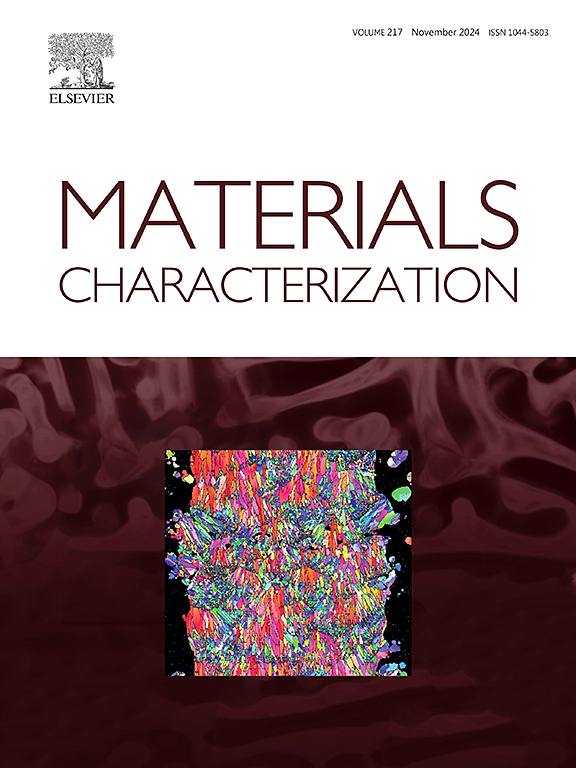Influence of aging treatment on corrosion behaviors and mechanical properties of Al-4.0Cu-0.9Li-0.4 Mg alloy
IF 4.8
2区 材料科学
Q1 MATERIALS SCIENCE, CHARACTERIZATION & TESTING
引用次数: 0
Abstract
The mechanical properties, intergranular and exfoliation corrosion of the T6-aged and T8-aged Al-4.0Cu-0.9Li-0.4Mg alloys were systematically investigated, and the stress corrosion behavior was characterized by slow strain tensile tests and direct current potential drop (DCPD) method. It was revealed that T8-aged specimens showed a higher intergranular and exfoliation corrosion resistance, and their stress corrosion susceptibility factors (ISSRT) were decreased compared to T6-aged specimens. Additionally, the stress corrosion cracking propagation rate of T6-aged specimens along the rolling direction (T6-RD) is higher than that of the T8-aged specimens along the rolling direction (T8-RD), which is mainly attributed to the precipitation-free zones and the secondary phase particles at grain boundaries in T6-aged alloys. However, the DCPD results showed that the T6-aged specimens along the transverse direction (T6-TD) exhibited enhanced stress corrosion resistance than T6-RD samples, resulting from the retardation effect of grain boundaries and sub-grains zones on crack tips. Meanwhile, the stress corrosion cracking propagation was dependent on the adjacent grain orientation, and the cracks were inclined to deviate from the grain boundaries to the intragranular when the twist angle difference between adjacent grains was relatively low. Thus, for T6-RD and T6-TD samples or the T6-TD and T8-RD samples, conventional intergranular corrosion and exfoliation corrosion indexes are not appropriate, and corrosion susceptibility should instead be evaluated using the complex DCPD method.

时效处理对Al-4.0Cu-0.9Li-0.4 Mg合金腐蚀行为和力学性能的影响
系统研究了t6时效和t8时效Al-4.0Cu-0.9Li-0.4Mg合金的力学性能、晶间腐蚀和剥落腐蚀,并采用慢应变拉伸试验和直流电位降(DCPD)法对其应力腐蚀行为进行了表征。结果表明,与t6时效试样相比,t8时效试样具有更高的抗晶间腐蚀和抗剥落腐蚀性能,其应力腐蚀敏感性因子(ISSRT)降低。此外,t6时效试样沿轧制方向(T6-RD)的应力腐蚀裂纹扩展速率高于沿轧制方向(T8-RD)的应力腐蚀裂纹扩展速率,这主要是由于t6时效合金晶界处存在无析出区和二次相颗粒。然而,DCPD结果表明,由于裂纹尖端的晶界和亚晶带的延迟作用,沿横向(T6-TD)时效试样的抗应力腐蚀能力比T6-RD样品强。同时,应力腐蚀裂纹的扩展依赖于相邻晶粒的取向,当相邻晶粒的扭转角差较小时,裂纹倾向于偏离晶界向晶内扩展。因此,对于T6-RD和T6-TD或T6-TD和T8-RD样品,常规的晶间腐蚀和剥落腐蚀指标不适用,应采用复合DCPD方法评价腐蚀敏感性。
本文章由计算机程序翻译,如有差异,请以英文原文为准。
求助全文
约1分钟内获得全文
求助全文
来源期刊

Materials Characterization
工程技术-材料科学:表征与测试
CiteScore
7.60
自引率
8.50%
发文量
746
审稿时长
36 days
期刊介绍:
Materials Characterization features original articles and state-of-the-art reviews on theoretical and practical aspects of the structure and behaviour of materials.
The Journal focuses on all characterization techniques, including all forms of microscopy (light, electron, acoustic, etc.,) and analysis (especially microanalysis and surface analytical techniques). Developments in both this wide range of techniques and their application to the quantification of the microstructure of materials are essential facets of the Journal.
The Journal provides the Materials Scientist/Engineer with up-to-date information on many types of materials with an underlying theme of explaining the behavior of materials using novel approaches. Materials covered by the journal include:
Metals & Alloys
Ceramics
Nanomaterials
Biomedical materials
Optical materials
Composites
Natural Materials.
 求助内容:
求助内容: 应助结果提醒方式:
应助结果提醒方式:


